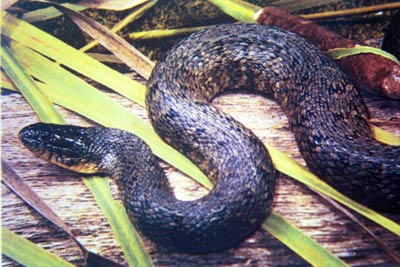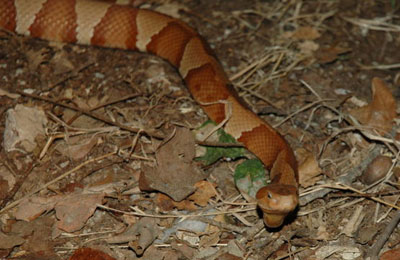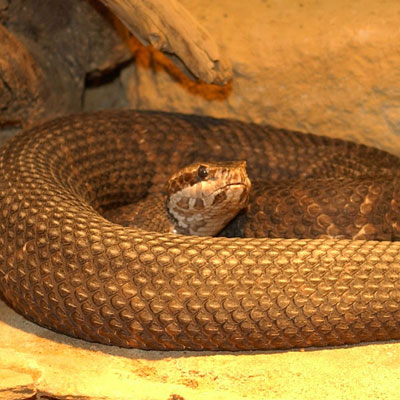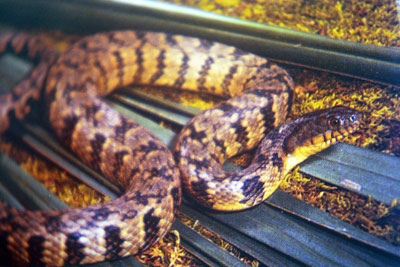Nature King Pest Management
972-524-0090
P.O. Box 721133
Dallas, Tx. 75372
Snake Control
Snakes, in their proper environment, are balance machines set to the tune of nature. They keep our insect population controlled (as well as mice and rats that might be in their scope). However, that's hardly the thought we have when one crawls across the kitchen floor at coffee time or if we happen to see a tail slither into the blind side of the garage. Our first step of a snake control operation is to look for why this particular male or female snake is attracted to your structure. Our first inclination would be food source, followed by possible hibernation issues. Snakes will provide information - you just have to look for the signs. To further positively I.D. Non-venomous snakes exhibit a single row of scales that split below the anus. This split is not present in venomous snakes - the scales stays in a single row all the way down to the tip of the tail body. This can be noted by examining shedded snake skins (attic inspection). If the snake is actually seen, we ask the homeowner if they noticed the shape of the head, which is another way to identify the snake species. Blotched Water SnakeIf this snake can't escape danger, this reptile will flatten its head and neck and strike several times in succession. Most of its strikes are "bluffs", and those that do connect ordinarily result in only a warning nip. This snake's habitat ranges throughout most parts of Texas, and will move on into homes and live in the attic of a rodent-infested structure. It does need water all of the time. Food sources for these types of snakes are usually fish, toads, frogs, skinks and geckos. However, they will eat rodents if that is the only nutritional support that they have at the time. They have dark-bordered pale bars that are generally dimly evident along the spine, while the belly is yellow. The larger of these reptiles have scale plates that are light-colored brown along the edges. The anal plate is divided on this snake. These snakes are confused with the western cottonmouth snake all of the time. The round pupils and narrower head makes the identification easier. The western cottonmouth has a sizable dark heat-sensing pit between the eyes and nostril, and an angular head whose flat, undercut cheeks abruptly intersect its crown. The cottonmouth also has a rather thick body. Yellowbelly Water SnakeThe yellowbelly water snake occurs throughout East Central Texas. The typical "yellowbelly" is unmarked, while the posterior edges of the belly scales are a lighter yellow. All water snakes have similarities with each other. Sometimes it can be difficult to I.D. these guys on quickly because of their darker skin. Broad-Banded Water SnakeA broad-banded water snake is quite different then most water snakes, and can be identified quickly and easily. It has a dappled yellow belly and is usually marked with large brown rectangular patches. Some of these snakes are very colorful and have bright red and yellow patterns on them. Believe it or not, the female can have up to 50 live bearing young but most bear about 15. The broad-banded water snake likes to inhabit areas of water that do not have swift currents, and they are most active at night. Their diet is much like other water snakes, but they do have a sweet tooth for crawfish. So crawfish holes in high water table lands might have a broad-banded snake or two. Broad-Banded CopperheadVenomous. Often very common in areas of ideal habitat, typically light to moderate ground cover under a leafy sylvan canopy - including wooded suburban residential areas. Prime deciduous forest-meadow may support as many as 7 snakes per acre. These snakes are live-bearing, and the mating period is both late fall and early spring - after that, females go into their winter retirement. The young can be born during the latter part of July all the way through September. Four to eight neonates are 71/2 to 10 inches long and generally have paler dorsal pigmentation than their parent. There are various other snakes that do resemble copperheads, so if there is a snake sighting or any inclination that there might be one, please call Nature King Pest Management for professional assistance. 
A Broad-Banded Copperhead that was photographed in a house back yard. When this type of snake is in the
back yard, it's time to perform some means of snake control and prevention. Photo courtesy of www.kfbphoto.com
Cottonmouth SnakeDespite the cottonmouth's formidable reputation, comparatively few people are bitten. Only about 7 percent of Texas' snake bites involve the cottonmouth, while throughout the United States the mortality rate is less than one person per year. Though rarely fatal, is often serious in terms of tissue death, for while its toxins have far less lethal potency than those of the western diamondback rattlesnakes, their destructiveness toward blood cells and plasma is nearly 9 percent greater than those of the diamondback. Frogs are this viper's most frequent prey in most locales, but they are an indiscriminate feeder whose diet alters with the availability of different vertebrate prey, including fish, mammals as large as the young of muskrats and cottontails, water birds, and sizable water snakes, as well as copperheads and smaller cottonmouths. These snakes are live-bearing and have from 3 to 12 young (the average is about 5). The length is from 7 1/2 to 11 inches. The coloring of the cottonmouth is dark and the body sometimes seems large in the middle, but that is normal for this snake. The cottonmouth is a water snake and has been confused with all types of water snakes. If you have a snake encounter, it is always critical to call upon a professional Like Nature King Pest Management. 
A venomous cottonmouth snake.

A non-venomous red bull snake.
|
| Copyright 2002-2006 www.natureking.com, all rights reserved |